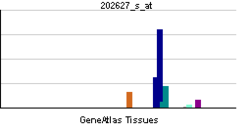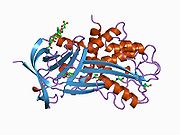- Plasminogen activator inhibitor-1
-
Plasminogen activator inhibitor-1 (PAI-1) also known as endothelial plasminogen activator inhibitor or serpin E1 is a protein that in humans is encoded by the SERPINE1 gene.
PAI-1 is a serine protease inhibitor (serpin) that functions as the principal inhibitor of tissue plasminogen activator (tPA) and urokinase (uPA), the activators of plasminogen and hence fibrinolysis (the physiological breakdown of blood clots). It is a serine protease inhibitor (serpin) protein (SERPINE1).
The other PAI, plasminogen activator inhibitor-2 (PAI-2) is secreted by the placenta and only present in significant amounts during pregnancy. In addition, protease nexin acts as an inhibitor of tPA and urokinase. PAI-1, however, is the main inhibitor of the plasminogen activators.
Contents
Genetics
The PAI-1 gene is officially called SERPINE1 and is located on the seventh chromosome (7q21.3-q22). There is a common polymorphism known as 4G/5G in the promoter region. The 5G allele is slightly less transcriptionally active than the 4G.
Function
PAI-1 is mainly produced by the endothelium (cells lining blood vessels), but is also secreted by other tissue types, such as adipose tissue.
PAI-1 inhibits the serine proteases tPA and uPA/urokinase, and hence is an inhibitor of fibrinolysis, the physiological process that degrades blood clots.
PAI-1 inhibits the activity of matrix metalloproteinases, which play a crucial role in invasion of malignant cells across the basal lamina.
 Fibrinolysis (simplified). Blue arrows denote stimulation, and red arrows inhibition.
Fibrinolysis (simplified). Blue arrows denote stimulation, and red arrows inhibition.Role in disease
Congenital deficiency of PAI-1 has been reported; as fibrinolysis is not suppressed adequately, it leads to a hemorrhagic diathesis (a tendency to hemorrhage).
PAI-1 is present in increased levels in various disease states (such as a number of forms of cancer), as well as in obesity and the metabolic syndrome. It has been linked to the increased occurrence of thrombosis in patients with these conditions.
In inflammatory conditions in which fibrin is deposited in tissues, PAI-1 appears to play a significant role in the progression to fibrosis (pathological formation of connective tissue). Presumably, lower PAI levels would lead to less suppression of fibrinolysis and conversely a more rapid degradation of the fibrin.
Angiotensin II increases synthesis of plasminogen activator inhibitor-1, so it accelerates the development of atherosclerosis.
Pharmacology
Tiplaxtinin (PAI-039) is a small molecule inhibitor that is being studied for use in the attenuation of remodeling of blood vessels, a result of arterial hypertension and activation of the renin-angiotensin system.[1]
Interactions
Plasminogen activator inhibitor-1 has been shown to interact with ORM1.[2]
References
- ^ Elokdah H, Abou-Gharbia M, Hennan JK, McFarlane G, Mugford CP, Krishnamurthy G, Crandall DL. Tiplaxtinin, a novel, orally efficacious inhibitor of plasminogen activator inhibitor-1: design, synthesis, and preclinical characterization. J Med Chem 2004;47:3491-4. PMID 15214776.
- ^ Boncela, J; Papiewska I, Fijalkowska I, Walkowiak B, Cierniewski C S (Sep. 2001). "Acute phase protein alpha 1-acid glycoprotein interacts with plasminogen activator inhibitor type 1 and stabilizes its inhibitory activity". J. Biol. Chem. (United States) 276 (38): 35305–11. doi:10.1074/jbc.M104028200. ISSN 0021-9258. PMID 11418606.
Further reading
- Mimuro J (1991). "[Type 1 plasminogen activator inhibitor: its role in biological reactions]". Rinsho Ketsueki 32 (5): 487–9. PMID 1870265.
- Binder BR, Christ G, Gruber F et al. (2002). "Plasminogen activator inhibitor 1: physiological and pathophysiological roles". News Physiol. Sci. 17: 56–61. PMID 11909993.
- Eddy AA (2002). "Plasminogen activator inhibitor-1 and the kidney". Am. J. Physiol. Renal Physiol. 283 (2): F209–20. doi:10.1152/ajprenal.00032.2002. PMID 12110504.
- Schroeck F, Arroyo de Prada N, Sperl S et al. (2003). "Interaction of plasminogen activator inhibitor type-1 (PAI-1) with vitronectin (Vn): mapping the binding sites on PAI-1 and Vn". Biol. Chem. 383 (7–8): 1143–9. doi:10.1515/BC.2002.125. PMID 12437099.
- Gils A, Declerck PJ (2004). "The structural basis for the pathophysiological relevance of PAI-I in cardiovascular diseases and the development of potential PAI-I inhibitors". Thromb. Haemost. 91 (3): 425–37. doi:10.1160/TH03-12-0764. PMID 14983217.
- Durand MK, Bødker JS, Christensen A et al. (2004). "Plasminogen activator inhibitor-I and tumour growth, invasion, and metastasis". Thromb. Haemost. 91 (3): 438–49. doi:10.1160/TH03-12-0784. PMID 14983218.
- Harbeck N, Kates RE, Gauger K et al. (2004). "Urokinase-type plasminogen activator (uPA) and its inhibitor PAI-I: novel tumor-derived factors with a high prognostic and predictive impact in breast cancer". Thromb. Haemost. 91 (3): 450–6. doi:10.1160/TH03-12-0798. PMID 14983219.
- Hertig A, Rondeau E (2004). "Plasminogen activator inhibitor type 1: the two faces of the same coin". Curr. Opin. Nephrol. Hypertens. 13 (1): 39–44. doi:10.1097/00041552-200401000-00006. PMID 15090858.
- Hoekstra T, Geleijnse JM, Schouten EG, Kluft C (2004). "Plasminogen activator inhibitor-type 1: its plasma determinants and relation with cardiovascular risk". Thromb. Haemost. 91 (5): 861–72. doi:10.1267/THRO04050861. PMID 15116245.
- Lijnen HR (2005). "Pleiotropic functions of plasminogen activator inhibitor-1". J. Thromb. Haemost. 3 (1): 35–45. doi:10.1111/j.1538-7836.2004.00827.x. PMID 15634264.
- De Taeye B, Smith LH, Vaughan DE (2005). "Plasminogen activator inhibitor-1: a common denominator in obesity, diabetes and cardiovascular disease". Current opinion in pharmacology 5 (2): 149–54. doi:10.1016/j.coph.2005.01.007. PMID 15780823.
- Dellas C, Loskutoff DJ (2005). "Historical analysis of PAI-1 from its discovery to its potential role in cell motility and disease". Thromb. Haemost. 93 (4): 631–40. doi:10.1267/THRO05040631. PMID 15841306.
- Könsgen D, Mustea A, Lichtenegger W, Sehouli J (2005). "[Role of PAI-1 in gynaecological malignancies]". Zentralblatt für Gynäkologie 127 (3): 125–31. doi:10.1055/s-2005-836407. PMID 15915389.
- Vaughan DE (2005). "PAI-1 and atherothrombosis". J. Thromb. Haemost. 3 (8): 1879–83. doi:10.1111/j.1538-7836.2005.01420.x. PMID 16102055.
- Hermans PW, Hazelzet JA (2007). "Plasminogen activator inhibitor type 1 gene polymorphism and sepsis". Clin. Infect. Dis. 41 Suppl 7: S453–8. doi:10.1086/431996. PMID 16237647.
- Alessi MC, Poggi M, Juhan-Vague I (2007). "Plasminogen activator inhibitor-1, adipose tissue and insulin resistance". Curr. Opin. Lipidol. 18 (3): 240–5. doi:10.1097/MOL.0b013e32814e6d29. PMID 17495595.
PDB gallery 1a7c: HUMAN PLASMINOGEN ACTIVATOR INHIBITOR TYPE-1 IN COMPLEX WITH A PENTAPEPTIDE1b3k: Plasminogen activator inhibitor-11c5g: PLASMINOGEN ACTIVATOR INHIBITOR-11db2: CRYSTAL STRUCTURE OF NATIVE PLASMINOGEN ACTIVATOR INHIBITOR-11dvm: ACTIVE FORM OF HUMAN PAI-11dvn: LATENT FORM OF PLASMINOGEN ACTIVATOR INHIBITOR-1 (PAI-1)1lj5: 1.8A Resolution Structure of Latent Plasminogen Activator Inhibitor-1(PAI-1)1oc0: PLASMINOGEN ACTIVATOR INHIBITOR-1 COMPLEX WITH SOMATOMEDIN B DOMAIN OF VITRONECTIN9pai: CLEAVED SUBSTRATE VARIANT OF PLASMINOGEN ACTIVATOR INHIBITOR-1External links
- The MEROPS online database for peptidases and their inhibitors: I04.020
- MeSH Plasminogen+Activator+Inhibitor+1
Proteins: coagulation Coagulation factors Coagulation inhibitors Thrombolysis/fibrinolysis inhibitory Alpha 1-antichymotrypsin · Alpha 1-antitrypsin · Alpha 2-antiplasmin · Antithrombin · C1-inhibitor · Heparin cofactor II · Protein C inhibitor · Plasminogen activator inhibitor-1 · Plasminogen activator inhibitor-2 · Protein Z-related protease inhibitor
SERPINA1 · SERPINA2 · SERPINA3 · SERPINA4 · SERPINA5 · SERPINA6 · SERPINA7 · SERPINA8 · SERPINA9 · SERPINA14
SERPINB1 · SERPINB2 · SERPINB3 · SERPINB4 · SERPINB5 · SERPINB6 · SERPINB7 · SERPINB8 · SERPINB9 · SERPINB13
SERPINC1 · SERPIND1 · SERPINE1 · SERPINE2 · SERPINE2 · SERPINF1 · SERPING1 · SERPINH1 · SERPINI1 · SERPINI2Cross class inhibitory noninhibitory see also disorders of globin and globulin proteins Categories:- Human proteins
- Fibrinolytic system
- Serine protease inhibitors
Wikimedia Foundation. 2010.












